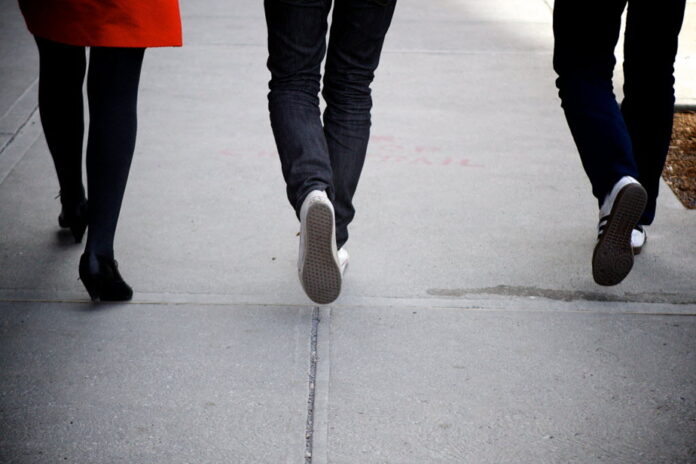Canadians have been unlocking their iPhones with their fingerprint since 2013 and are sometimes exposed to facial recognition software before boarding planes, but when it comes to biometric technology, Erik Scheme and Mayssa Rekik have a head start.
The associate director of the University of New Brunswick’s Institute of Biomedical Engineering and the advanced technology undergraduate student are part of a team researching what the future of biometric security might be: The footsteps.
They installed electronic tiles from Prince Edward Island-based Stepscan Technologies in their university lab and in the lobby of the Cyber Center in Fredericton to generate a pixel-by-pixel heat map of the distribution of the pressure in a person’s feet as they walk.
The heel-to-toe data they capture will help develop 3D models of people walking on the tiles and deep learning frameworks that can differentiate one person’s walk from another, to identify individuals based on of their approach.
“Whether it’s different shoes, wearing different objects, or distracted walking, we’re trying to create the largest data set in the world to make available to the research community, so we can make advance this discipline,” Mr. Scheme said.
Interest in biometric technology, which relies on unique physical characteristics such as a person’s gait, retina, face, heart rate or voice, is growing in part because most businesses rely on keys, cards, personal or personnel identification numbers to secure access to their spaces or systems.
These methods often require people to rummage through bags for keys and cards, try to remember passwords, or seek help from system administrators or security guards when they are without means of entry.
Some companies have tried to ditch these methods by turning to fingerprint and facial scanners, but none are completely foolproof.
Lighting conditions, masks and other accessories can challenge face scanners, while people wearing gloves and those wishing to avoid touching additional surfaces in a COVID-19 aware world pose challenges for systems based on fingerprints.
“The walk creates an interesting opportunity because not only is it contactless, you don’t even have to stop, you just keep walking and we can authenticate you that way,” Scheme explained. It is a new modality. »
Mayssa Rekik, who came to Canada from Tunisia for three months to help work on the Gait Project with help from the non-profit research organization Mitacs, sees several obvious uses for the technology. .
“It would be really useful for security reasons and it could be used for airports or for a building entrance,” she said.
While banks were once among the industries most interested in the technology due to the sheer amount of sensitive data they process, enthusiasm for biometric systems has waned greatly recently, Imran Ahmad said.
The chief technology officer at law firm Norton Rose Fulbright attributed the setback to a flurry of litigation and controversy in the United States over the use of biometrics.
San Francisco and Oakland, California, as well as Somerville, Massachusetts, banned the use of facial recognition technology by city agencies in 2019. Many bans were issued following issues with the technology to recognize women and racialized populations.
“Right now, it’s kind of a pattern. Let’s wait and see, like where is this going to go in Canada? “, he said.
Concerns about biometrics are part of why Scheme’s team took a cautious approach to their research.
Cyber Center employees who walk on the tiles first had to give their individual consent to be part of the research, as did a second group who visit the lab for more specialized tests, where their data is collected as they walk. naked, in specific shoes, or carrying a backpack or briefcase.
In both scenarios, all data is anonymized, which means that it is stripped of its personal information and used as part of a larger anonymous repository.
The team hopes the research will become the basis for future biometric innovations by helping to determine how unique our gait is, and whether the technology can detect changes when we encounter obstacles or even when we change shoes.
“Certainly if you fall and break your leg, there’s probably going to be a problem in the same way that if you use a fingerprint system and you cut your thumb, it doesn’t work either,” Mr. Scheme said.
He thinks machine learning models will eventually learn which features of our gait don’t change even if someone suddenly limps along, slows their pace, or even ditch their high heels in favor of midday running shoes.
However, before gait-based biometrics can enter offices or other places that require secure access, companies must consider laws and other regulations.
The Privacy Commissioner of Canada, for example, has developed guidelines requiring anyone collecting sensitive information, including biometric data, to first obtain explicit and meaningful consent, Ahmad pointed out. .
In Quebec, anyone creating a database of biometric characteristics or measurements must disclose its existence to the province’s access to information commission at least 60 days before it is put into service.
Mr. Ahmad suspects that more regulations are on the way. Although they’re giving an extra break, he doesn’t think they’ll spell the end of the tech.
“Biometrics is here to stay,” he said. It’s not something we’re just going to turn our backs on. It will be part of our lives. »















